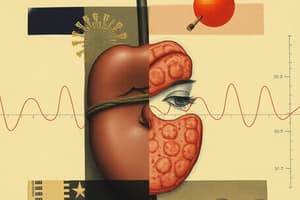Podcast
Questions and Answers
Which branch of pharmacology is dedicated to describing how the body affects a specific substance after administration?
Which branch of pharmacology is dedicated to describing how the body affects a specific substance after administration?
- Pharmacodynamics
- Pharmaceutics
- Pharmacogenomics
- Pharmacokinetics (correct)
What does the acronym ADME stand for in pharmacokinetics?
What does the acronym ADME stand for in pharmacokinetics?
- Analysis, Drug, Metabolism, Effect
- Administration, Dosage, Metabolism, Elimination
- Absorption, Distribution, Metabolism, Excretion (correct)
- Acute, Drug, Metabolism, Excretion
What is the relationship between pharmacokinetics and pharmacodynamics?
What is the relationship between pharmacokinetics and pharmacodynamics?
- Pharmacokinetics and pharmacodynamics are completely unrelated.
- Pharmacokinetics studies how the drug affects the organism, while pharmacodynamics studies how the organism affects the drug. (correct)
- Pharmacokinetics and pharmacodynamics are synonymous terms.
- Pharmacokinetics and pharmacodynamics are two branches of pharmacology that do not interact.
In the single-compartment model, what is the most common model of elimination?
In the single-compartment model, what is the most common model of elimination?
In the two-compartment model, where does elimination commonly occur?
In the two-compartment model, where does elimination commonly occur?
Which factor can affect a drug's non-linearity?
Which factor can affect a drug's non-linearity?
Bioavailability is defined as the proportion of the drug that reaches its site of action. What is the bioavailability of a drug administered intravenously?
Bioavailability is defined as the proportion of the drug that reaches its site of action. What is the bioavailability of a drug administered intravenously?
What is the formula to calculate the amount of a drug in the blood plasma that has the potential to bring about its effect?
What is the formula to calculate the amount of a drug in the blood plasma that has the potential to bring about its effect?
Which of the following is true about steady state in pharmacokinetics?
Which of the following is true about steady state in pharmacokinetics?
What is the advantage of compartmental analysis over noncompartmental analysis in pharmacokinetics?
What is the advantage of compartmental analysis over noncompartmental analysis in pharmacokinetics?
What is the main focus of ecotoxicology?
What is the main focus of ecotoxicology?
Study Notes
Pharmacokinetics
- Pharmacokinetics is the branch of pharmacology that describes how the body affects a specific substance after administration.
ADME
- ADME stands for Absorption, Distribution, Metabolism, and Excretion in pharmacokinetics.
Pharmacokinetics and Pharmacodynamics
- Pharmacokinetics describes the movement of a drug in the body, while pharmacodynamics describes the effect of the drug on the body.
Single-Compartment Model
- In the single-compartment model, the most common model of elimination is first-order elimination.
Two-Compartment Model
- In the two-compartment model, elimination commonly occurs in the central compartment.
Non-Linearity
- Non-linearity can be affected by factors such as saturation of metabolic pathways or protein binding.
Bioavailability
- Bioavailability is the proportion of the drug that reaches its site of action.
- Bioavailability is 100% for a drug administered intravenously.
Formula to Calculate Drug Concentration
- The formula to calculate the amount of a drug in the blood plasma that has the potential to bring about its effect is: Conc. = Dose / (Vd * ka).
Steady State
- At steady state, the rate of drug administration is equal to the rate of drug elimination.
Compartmental Analysis
- The advantage of compartmental analysis over noncompartmental analysis is that it provides a more detailed understanding of the pharmacokinetic processes.
Ecotoxicology
- The main focus of ecotoxicology is the study of the effects of toxic substances on ecosystems.
Studying That Suits You
Use AI to generate personalized quizzes and flashcards to suit your learning preferences.
Description
Understanding the Limitations of Compartment Models in Drug Distribution: Take this quiz to explore the simplifying assumptions and constraints of compartment models used in pharmacokinetics. Test your knowledge on the accuracy and applicability of these models in representing drug distribution within an organism.



